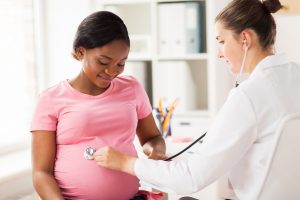Please join us for our capstone event – Thursday September 23, 2021 at 6 to 7 PM CST
Learn more and register here.
Something is undermining health at home, in the soil, and on the farm.
We spend more on healthcare per capita than any other nation. Life expectancy is shrinking. A costly trifecta of chronic diseases — diabetes, heart disease and high blood pressure — are on the rise and often rooted in poor food quality and unhealthy dietary choices.
All signs point to more trouble ahead for the next generation. The birth rate has fallen below the death rate in over 20 states. A growing number of women are having trouble conceiving. Difficult deliveries of low-birth weight and pre-term infants are on the rise. Nearly one-half of 5- to 11-year-old children are overweight, and far too many are headed for obesity in their 20s.
Over 90 million people call the Midwest home. Are exposures to weed killers across the Heartland causing or contributing to adverse birth outcomes and developmental problems in children? HHRA is laser-focused on finding answers, and designed The Heartland Study to do so.

Why worry? Across the Midwest farmers are struggling to deal with the proliferation of herbicide-resistant superweeds caused by excessive reliance on herbicides. Since 2015 herbicides known to cause reproductive problems and damage DNA have accounted for most of the growth in pounds applied. Herbicide use is bound to rise further because farmers are trapped on a herbicide treadmill stuck in high gear.
Our work is led by doctors, scientists and clinicians who see day-in and day-out the human face of these trends. We are determined to find out why reproductive and children’s health is declining. Recent science and the ominous spread of superweeds in the Midwest compels a harder look at corn-soybean farming systems and the chemicals now needed to bring a crop to harvest. Is the contemporary mix of farm chemicals linked to adverse birth outcomes, and if yes, which ones? Can policy reforms both promote climate-smart changes in farming systems and adoption of Integrated Weed Management systems? What needs to happen to help farmers back off the herbicide treadmill?
Finding solid answers grounded in rigorous science. Sharing lessons learned widely — no sugar coating allowed. And forging consensus on policy innovation is what HHRA was founded to do. And it is why we need your support.
See the sections below for more about our organization and our work:
- HHRA Mission and Model
- Board and Advisors
- Our Flagship Project: The Heartland Study
- Research Partners
- Our Four Pressing Needs
HHRA Mission and Model

The Heartland Health Research Alliance conducts and funds research in support of “Food and Farming for Health.” Health of the land. Health of farmers and workers along food and fiber supply chains, and the health of rural communities. Humane living conditions and good health for the animals raised to feed people. Health for all people and future generations and the planet we rely on.
HHRA brings together the ingredients required for successful public health research: skilled and experienced people, opportunities to partner with clinicians and their patients, a diversity of research tools and data, and analytical labs and systems. And we then use our communication and outreach tools, platforms and partners to widely share new science and insights. We do so because an informed and motivated public is essential to bring about the systemic change needed to effectively address contemporary food system challenges.
We also have unique ability to secure funding from multiple sources encompassing small and large private foundations, individuals, government agencies, aligned research institutions, health care providers and insurers. We recognize the need to invest significant resources in all aspects of our work — science, communications and policy — since meaningful change depends on all three.
Too often, research funding runs out before scientists have fully completed their work, leaving little time and no funding dedicated to sharing new insights. Likewise, far too much important science fails to find its way into the policy process where it is often most urgently needed.
This is why HHRA builds in significant and sustained funding for communications and policy work into our projects — before they start, as our science progresses and after the last results paper is published. Our policy experts understand where and how to share HHRA science to create leverage in ongoing policy deliberations.
We are determined to build and deploy our communication program and platforms in step with the need to infuse HHRA science in evolving policy processes. The ability to drive policy change through effective engagement and communications has to be honed, refined and deployed with the same professionalism and skill as HHRA scientific and clinical work. We pledge to do so, but we need your help in securing the ongoing funding needed to accomplish this goal.
Board and Advisors
HHRA Board of Directors
- Chair: Tom Green, Co-Founder of the IPM Institute of North America
- Vice-Chair: Robin Greenwald, Lead Attorney for Environmental Toxic Torts and Consumer Protection at Weitz & Luxenberg
- Secretary: Marlaina Friestler, PhD Student at George Washington University’s Milken Institute School of Public Health
- Dr. Jeanne Conry, CEO at Environmental Health Leadership Foundation and President, of the FIGO Reproductive and Environmental Health Working Group
- Dr. David Haas, Vice Chair of OBGYN Research at the University of Indiana School of Medicine
- Audrey Tran Lam, Environmental Health Program Manager at the University of Northern Iowa Center for Energy and Environmental Education (CEEE)
Advisory Board Chairs
- Science Advisory Board Chair: Dr. Phil Landrigan, Founding Director of the Global Public Health Program and Global Pollution Observatory at Boston College
- Communications, Outreach and Education Advisory Committee Chair and Co-Founder of The Heartland Study: Theresa Marquez
- Policy Advisory Committee Chair: Kathleen Merrigan
Our Flagship Project: The Heartland Study

The goal of The Heartland Study (HS) is to enroll 2,000 mother-infant pairs (MIPs) in our scientific protocol. Phase 1 of the protocol encompasses the onboarding of women during the first trimester of pregnancy, collecting two to three urine samples, tracking the women’s health through delivery, and recording the health of the newborn. Phase 2 will tract the development of children born into the HS protocol through, we hope, age 16, with focus on neurodevelopment, IQ, autism and ADHD, the presence of epigenetic impacts and general health status.
Our study region encompasses the twelve states in the Midwest Census Bureau region plus Arkansas. Three hospitals in Indiana and Wisconsin are active study sites and are beginning to enroll new MIPs after an 18-month hiatus caused by the Covid-19 pandemic. About 170 MIPs have been enrolled in the protocol to date.
We will recruit four new hospital study sites in new states by the end of 2022 if sufficient funding can be secured. Each new study site will enroll at least 60 MIPs per year once fully up and running. Approximately $300k in new funding is required to support the additional of a new study site where MIPs will be enrolled in Phase 1 for the HS protocol for up to three years.
The ability of a birth cohort study to detect associations between prenatal chemical exposures and birth outcomes and developmental trajectories depends on three things. First, the larger the n, i.e. the number of MIPs enrolled and tracked through the protocol, the more likely the study will detect associations between exposures and specific outcomes.
Second, accurate estimates of exposures across the women enrolled in a birth cohort study is essential. This is why we are measuring actual levels of herbicides and other chemicals in women’s urine. Such direct measures are the gold standard in designing birth cohort studies. Nearly one-quarter of the total Heartland Study budget will be required to cover laboratory costs. The Heartland Study will generate by far the largest dataset on actual herbicide exposure levels in pregnant women ever available, data that will support a number of important analyses for years to come.
Third, studies need to carefully select, track and record the adverse outcomes that will be monitored in the study population. The Heartland Study team is working on well-accepted outcomes like pre-term delivery, low-birth weight and behavioral abnormalities, as well as several new markers of often subtle metabolic, physiological or genetic disruptions linked to adverse health outcomes. These may include impacts on the liver and kidney, the microbiome, and genetic markers of adult-onset disease.
If we can raise the funding needed to bring 2,000 MIPs through the Heartland Study protocol, the HS will be the world’s largest and most sophisticated birth cohort study ever conducted that is focused on prenatal herbicide exposures. It is the kind of complex and costly science usually only undertaken via large government grants. But because tracking herbicide impacts on birth outcomes in the Midwest is not on the priority list of any government funding agency, HHRA is seeking the support needed to carry out this vital public health research.
Research Partners
Click here to see an interactive map of our research projects and partners.
Four Pressing Needs
Evidence is mounting that at least some of today’s health problems stem from the subtle ways chemical exposures can disrupt gene expression and the development of healthy immune, nervous and reproductive systems.
We are just now learning how some chemicals — including the world’s most widely used pesticide (glyphosate) — trigger worrisome shifts in the mix of bacteria in the human microbiome. New funding is needed to allow HHRA to press ahead with these priorities:
- Accelerate The Heartland Study mother-infant pair enrollments to at least 60 per month by spring 2022, to capture the impact (if any) of the big increase coming in the use of the herbicide 2,4-D in the next two to five years.
- Recruit four new hospitals into The Heartland Study in key states: Iowa, Ohio, Arkansas, Missouri, Nebraska (estimated cost ~$300K per study site).
- Expand our graduate fellowship and summer intern programs at academic partners like Boston College to advance HHRA science and encourage next-gen public health scientists to focus on food and farming.
- Finance critical new science on pesticide impacts on the microbiome, heritable epigenetic changes and children’s neurodevelopment via our extramural research partnership with Phil Landrigan and the Boston College program in Global Public Health and the Common Good.


